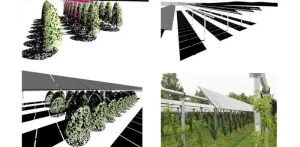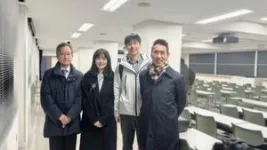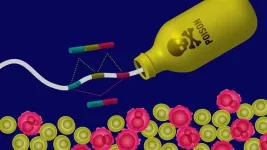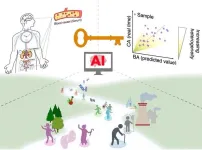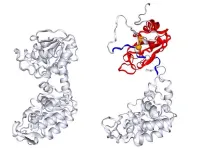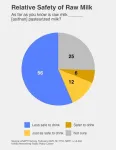(Press-News.org) Agrivoltaic systems, which combine solar power generation with agricultural practices, offer a promising solution to the growing demand for both renewable energy and food production. By integrating solar panels with crops, these systems not only address the land use conflict between agriculture and energy production, but they also provide important benefits such as reducing crop water stress and offering protection against extreme weather events. In addition, agrivoltaics can contribute to biodiversity by providing pollinator habitats and forage production. For ecosystems in water-scarce regions, these systems have been shown to increase flower production and delay blooming, which supports late-season pollinators. Research also shows that solar panels can perform better in agrivoltaic systems, thanks to the microclimate created underneath them.
As agrivoltaic systems become an increasingly important part of the global energy transition, the need for tailored tracking strategies to optimize their performance is growing. Horizontal single-axis tracker (HSAT) systems, which adjust the angle of solar panels throughout the day to track the sun, offer significant potential in this regard. Effective control of panel positioning helps balance the dual objectives of maximizing energy generation and preserving agricultural yields. Such optimization is particularly relevant as agrivoltaic systems need to meet yield loss thresholds in order to qualify for subsidies, thus improving their economic viability.
A recent study published in the Journal of Photonics for Energy (JPE) provides valuable insights into how solar panel positioning can be optimized to achieve this balance. The research focuses on a case study of apple orchards in southwestern Germany, but the findings are broadly applicable to various agricultural settings. The study proposes a new methodology for dynamically optimizing solar panel positioning based on the light needs of crops. Unlike traditional shading strategies, which are based on general guidelines or structures like hail nets, this new approach uses specific irradiation targets to meet the precise light requirements of different crop varieties. The research team ran simulations using a custom tool called APyV to assess how varying solar panel positions would impact light availability for the crops.
APyV uses advanced ray tracing techniques to evaluate the distribution of solar radiation and its impact on both the photovoltaic panels and the underlying crops. The tool automates design optimization of agrivoltaic systems based on key performance indicators, the interface with different crop models, and the integrated simulation of specialty crops. It allows direct calculation of the light received by the crop and a more accurate simulation of its impact on the overall agrivoltaic system.
The results of the case study revealed that with tailored solar panel control, 91 percent of the light needed for the apple trees was delivered over the course of the year, with only a moderate 20 percent reduction in solar energy production. However, the study also identified periods when the light requirements of the apple trees were not fully met, indicating the challenges of achieving optimal crop and energy performance simultaneously. Despite these limitations, the study lays a strong foundation for future research, which is already underway.
According to corresponding author Maddelena Bruno, who is leading the study as a doctoral candidate at Fraunhofer ISE, “Our study shows that the combination of solar energy and farming can be enhanced by smart PV-trackers that adjust the position of solar panels based on weather conditions, crop types, and their growth stages. This approach ensures an optimal balance between light available for photosynthesis and light available for electricity production.”
Bruno notes that the proposed irradiation targets and tracking strategy are to be field-tested during the current growing season in Nussbach, providing an opportunity to validate or challenge the reported results. These field tests will contribute significantly to a deeper understanding of the impact of agrivoltaic systems on apple orchards and the surrounding environment. Ultimately, this research will provide critical insights that can guide the optimization of agrivoltaic systems, making them more effective in balancing agricultural productivity and renewable energy generation while supporting the ongoing energy transition.
For details, see the original Gold Open Access article by M. Bruno et al., “Enhancing agrivoltaic synergies through optimized tracking strategies,” J. Photon. Energy 15(3), 032703 (2025), doi: 10.1117/1.JPE.15.032703.
END
Growing solar: Optimizing agrivoltaic systems for crops and clean energy
Combining solar energy and farming can be enhanced by smart PV-trackers that adjust solar panel positioning to ensure an optimal balance between light available for photosynthesis and light available for electricity production
2025-03-14
ELSE PRESS RELEASES FROM THIS DATE:
Scientists discover how to reactivate cancer’s molecular “kill switch”
2025-03-14
Alternative RNA splicing is like a movie editor cutting and rearranging scenes from the same footage to create different versions of a film. By selecting which scenes to keep and which to leave out, the editor can produce a drama, a comedy, or even a thriller—all from the same raw material. Similarly, cells splice RNA in different ways to produce a variety of proteins from a single gene, fine-tuning their function based on need. However, when cancer rewrites the script, this process goes awry, fueling tumor growth and survival.
In a recent study reported in the Feb. 15 issue of Nature ...
YouTube influencers: gaming’s best friend or worst enemy?
2025-03-14
New INFORMS Marketing Science Study Key Takeaways:
YouTube influencers increase player engagement and playtime but often reduce game purchases, especially for story-driven games.
A unique event in YouTube’s history, the “Adpocalypse,” allowed researchers to measure the causal impact of influencer content, revealing its complex effects on game sales and usage.
Game developers must align their business models with influencer marketing, because games with in-game purchases benefit from exposure, while ...
uOttawa scientists use light to unlock secret of atoms
2025-03-14
A team of researchers from the University of Ottawa has made significant strides in understanding the ionization of atoms and molecules, a fundamental process in physics that has implications for various fields including x-ray generation and plasma physics.
Think about atoms - the building blocks of everything around us. Sometimes, they lose their electrons and become charged particles (that's ionization). It happens in lightning, in plasma TVs, and even in the northern lights. Until now, scientists thought they could only control this process in limited ways.
Led by Ravi Bhardwaj, Full Professor at uOttawa’s Department of Physics, and PhD student Jean-Luc Begin, in collaboration ...
NJIT mathematician to help map Earth's last frontier with Navy grant
2025-03-14
We’ve mapped nearly all of Mars’ surface from orbit, yet we know less about Earth’s ocean floor — almost 75% remains unmapped in high resolution.
This terrestrial blind spot is driving NJIT Mathematics Professor Eliza Michalopoulou’s latest research, funded by the Office of Naval Research (ONR). The project aims to improve how scientists explore the vast, uncharted ocean floor through sound.
“Mapping the seabed is a challenging endeavor due to the extreme conditions,” said Michalopoulou, ...
NASA atmospheric wave-studying mission releases data from first 3,000 orbits
2025-03-14
Following the 3,000th orbit of NASA’s AWE (Atmospheric Waves Experiment) aboard the International Space Station, researchers publicly released the mission’s first trove of scientific data, crucial to investigate how and why subtle changes in Earth’s atmosphere cause disturbances, as well as how these atmospheric disturbances impact technological systems on the ground and in space.
“We’ve released the first 3,000 orbits of data collected by the AWE instrument in space and transmitted back to Earth,” said Ludger Scherliess, principal investigator for the mission and physics professor at Utah State University. “This is a view of atmospheric ...
‘Microlightning’ in water droplets may have sparked life on Earth
2025-03-14
Life may not have begun with a dramatic lightning strike into the ocean but from many smaller “microlightning” exchanges among water droplets from crashing waterfalls or breaking waves.
New research from Stanford University shows that water sprayed into a mixture of gases thought to be present in Earth’s early atmosphere can lead to the formation of organic molecules with carbon-nitrogen bonds, including uracil, one of the components of DNA and RNA.
The study, published in the journal Science Advances, adds evidence – and a new angle – to the much-disputed Miller-Urey ...
Smoke from wildland-urban interface fires more deadly than remote wildfires
2025-03-14
EMBARGOED until Friday, March 14 at 2:00 p.m. Eastern Time (12 noon MT)
Contacts:
David Hosansky, NSF NCAR and UCAR Manager of Media Relations
hosansky@ucar.edu
303-497-8611
Audrey Merket, NSF NCAR and UCAR Science Writer and Public Information Officer
amerket@ucar.edu
303-497-8293
The smoke from fires that blaze through the wildland-urban interface (WUI) has far greater health impacts than smoke from wildfires in remote areas, new research finds.
The study, published this week in Science Advances, estimates that emissions from WUI fires are proportionately about three times more likely to lead ...
What’s your body really worth? New AI model reveals your true biological age from 5 drops of blood
2025-03-14
Osaka-Japan - We all know someone who seems to defy aging—people who look younger than their peers despite being the same age. What’s their secret? Scientists at Osaka University (Japan) may have found a way to quantify this difference. By incorporating hormone (steroid) metabolism pathways into an AI-driven model, they have developed a new system to estimate a person’s biological age a measure of how well their body has aged, rather than just counting the years since birth.
Using just five drops of ...
Protein accidentally lassos itself, helping explain unusual refolding behavior
2025-03-14
UNIVERSITY PARK, Pa. — Proteins are long molecules that must fold into complex three-dimensional structures to perform their cellular functions. This folding process occasionally goes awry, resulting in misfolded proteins that, if not corrected, can potentially lead to disease. Now, a new study has described a potential mechanism that could help explain why some proteins refold in a different pattern than expected. The researchers, led by chemists at Penn State, found that a type of misfolding, in which the ...
With bird flu in raw milk, many in U.S. still do not know risks of consuming it
2025-03-14
PHILADELPHIA – Although the Food and Drug Administration (FDA) located H5N1 bird flu virus in samples of raw, or unpasteurized, milk in tests in four states in April 2024, and bird flu has been detected in commercially sold raw milk, many Americans do not know that consuming raw milk and its products poses greater health risks than consuming pasteurized milk and its products, especially for children. Consuming raw milk can expose one to Salmonella, E. coli, Campylobacter, Cryptosporidium, Listeria, and Brucella – and, potentially, H5N1 bird flu.
A majority of U.S. adults (56%) knows that drinking raw milk from cows, sheep, or goats is less safe than drinking pasteurized milk. ...
LAST 30 PRESS RELEASES:
Heart-brain connection: international study reveals the role of the vagus nerve in keeping the heart young
Researchers identify Rb1 as a predictive biomarker for a new therapeutic strategy in some breast cancers
Survey reveals ethical gaps slowing AI adoption in pediatric surgery
Stimulant ADHD medications work differently than thought
AI overestimates how smart people are, according to HSE economists
HSE researchers create genome-wide map of quadruplexes
Scientists boost cell "powerhouses" to burn more calories
Automatic label checking: The missing step in making reliable medical AI
Low daily alcohol intake linked to 50% heightened mouth cancer risk in India
American Meteorological Society announces Rick Spinrad as 2026 President-Elect
Biomass-based carbon capture spotlighted in newly released global climate webinar recording
Illuminating invisible nano pollutants: advanced bioimaging tracks the full journey of emerging nanoscale contaminants in living systems
How does age affect recovery from spinal cord injury?
Novel AI tool offers prognosis for patients with head and neck cancer
Fathers’ microplastic exposure tied to their children’s metabolic problems
Research validates laboratory model for studying high-grade serous ovarian cancer
SIR 2026 delivers transformative breakthroughs in minimally invasive medicine to improve patient care
Stem Cell Reports most downloaded papers of 2025 highlight the breadth and impact of stem cell research
Oxford-led study estimates NHS spends around 3% of its primary and secondary care budget on the health impacts of heat and cold in England
A researcher’s long quest leads to a smart composite breakthrough
Urban wild bees act as “microbial sensors” of city health.
New study finds where you live affects recovery after a hip fracture
Forecasting the impact of fully automated vehicle adoption on US road traffic injuries
Alcohol-related hospitalizations from 2016 to 2022
Semaglutide and hospitalizations in patients with obesity and established cardiovascular disease
Researchers ‘listen in’ to embryo-mother interactions during implantation using a culture system replicating the womb lining
How changing your diet could help save the world
How to make AI truly scalable and reliable for real-time traffic assignment?
Beyond fragmented markets: A new framework for efficient and stable ride-pooling
Can shape priors make road perception more reliable for autonomous driving?
[Press-News.org] Growing solar: Optimizing agrivoltaic systems for crops and clean energyCombining solar energy and farming can be enhanced by smart PV-trackers that adjust solar panel positioning to ensure an optimal balance between light available for photosynthesis and light available for electricity production
